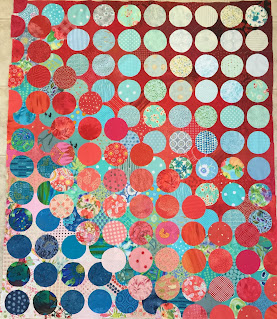Re-reading
Freddy's Houses recently I was struck by this statement:
"When I start building a quilt I hate the way it looks. The blocks are jumbled, messy, and chaotic, and the design makes no sense. I force myself to keep going, keep designing, until eventually I see order emerging from the chaos: 10 colors don't work, but 100 colors do!" - Freddy Moran
Who'd have thought Freddy and I start our quilts the same way?
I dislike many of my quilts near the beginning. In fact, I've found over the years that the quilts I like at the halfway point are the ones I am usually disappointed with by the end while those I am dissatisfied with midway through end up much better. Perhaps because I redouble my efforts to "correct" the laggards but fail to pay enough attention to the ones that seem to be working. Something to consider.
Chinese Coins and Roses
My bright idea of appliqueing on top of coins didn't exactly happen. I constantly {or is it consistently?} revert to piecing when facing a challenge. Making the roses was great fun. Stopping the rounds was much harder. Since I didn't turn the rose frequently enough my petals got larger and larger which forced me to stop before they became ludicrously long. {I still think my roses have more of a pineapple block feel. Not complaining; just noting. Next time I'll establish a maximum petal length and turn the block more frequently.}
Once the leaves were in place, determining how to insert the roses into the quilt was the next step. I created extra Coin sheets then sewed them to the rose to square off the design.
 |
Squaring up a rose
to fit into Chinese Coin columns |
The next decision was how many columns to fill behind the rose. The first two roses were wider than any Coin column. In the original arrangement (which I forgot to photograph) they fit across three narrow columns but the best solution set them across two columns. The sides of the rose “block” only needed a bit of trimming. {I had no idea upon starting that the roses would become blocks to be set in.}
 |
Sewing a rose block
into Chinese Coin columns |
The larger roses were finished first. As I was working around the smallest one, I found the top needed different sizes. And then realized it fit into the widest column very well.
 |
| Chinese Coins quilt with roses |
Putting a green column on the left evokes the leafy bushes. Those same greens didn’t work along the bottom. Instead I settled for mixing in extra green and grey coins. I also tried to make a soft border on the right by making small sets of alternating pairs of coins.
The quilt still doesn’t seem done but life is sad and crazy now. It’s better to wait and think. The top right is a lot of open space but adding a sun or bird isn’t the answer. Perhaps a vine connecting the roses? Or another rose near the bottom pair? Or trimming the quilt down a bit? Any vine should be chunky with lots of leaves.
Enjoy the day,
Ann



































